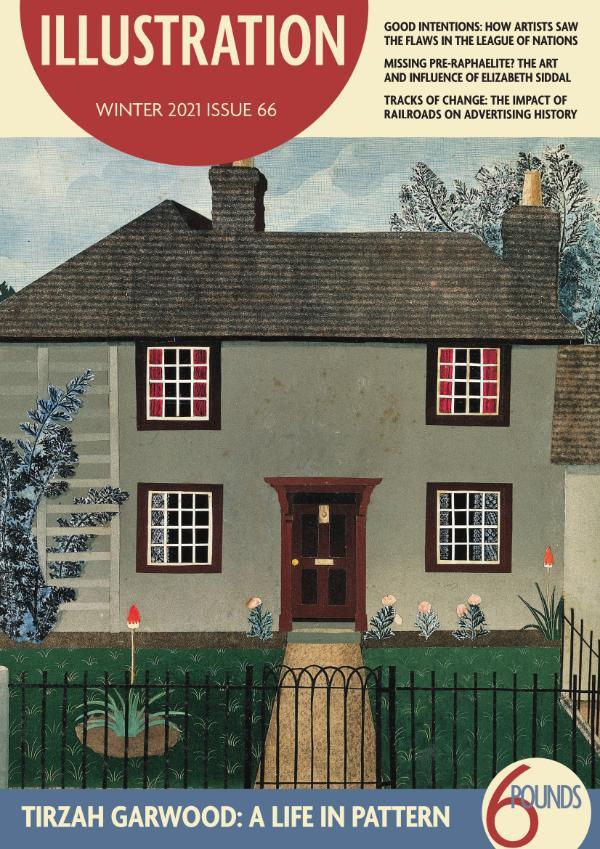
Illustration - Winter 2020 - Issue 66
Illustration Winter 2020 Issue 66
Contents
News and reviews
A brief round-up of current news stories, exhibitions and competitions – plus new books, reader offers, catalogues and websites, auction highlights and dates you need to remember.
Illustrator’s Notebook
Mick Manning has been sketching wildlife – and, in particular, birds – since he was at school. Even now, despite a busy career illustrating books and teaching, he continues to paint and sketch wild birds and animals and to use his notebooks as a resource for his paintings and books. Some fit in sketchbooks, while others are life-sized studies. He tells us what these sketches, both large and small, mean to him.
Tirzah Garwood
After many years in which she was known primarily as the wife of Eric Ravilious and as a member of the Great Bardfield group of artists, Garwood’s work has recently gained more attention in a couple of books by the Fleece Press and in successful exhibitions, such as “Ravilious & Co” at the Towner Gallery in Eastbourne. We discover the wood-engravings, collages, paintings and pattern papers created by Garwood throughout her life and find out why she deserves to be better remembered as a talented artist and illustrator in her own right.
Illustrating the League of Nations
Although it was lauded by many politicians, the League of Nations was derided by clear-sighted cartoonists for being idealistic, but weak and divided, and so fatally flawed from its inception. Why were the artists so much more perceptive than those in power and what do they tell us about public sentiment at the time? We consider the depictions of European leaders in the build-up to the second world war and their disturbingly accurate forecasts of future events.
Elizabeth Siddal
Her style was naïve and strongly influenced by the Arts & Crafts circle around her, but Elizabeth Siddal’s art was more than a pale imitation of the famous designs of her husband and teacher, Dante Gabriel Rossetti – indeed, there is evidence that her compositions and ideas often influenced his work – and he championed her inclusion in the celebrated “Moxon Tennyson”. We find out more about her and look at her few surviving works to find out more about the woman who features in many famous portraits yet whose own artistic voice was so seldom heard.
American railway graphics
The American railroads had a graphic style all of their own. We follow the trains across the continent to see how the railroads played a formative role in the country’s history – and how illustration played an important role in branding and selling the idea of train travel to US citizens.
Leonard Raven-Hill
As long-serving second cartoonist on Punch and a contributor to numerous other magazines and books, Leonard Raven-Hill was one of the best known and most successful cartoonists and illustrators of his day. We look at the wide range of his work, from first world war cartoons to illustrations for motoring books
Graduate round-up
Three young artists fresh from their degree courses in Brittany and at Cambridge School of Art discuss their current work, their inspirations and their ambitions for their future artistic careers.
Contributors
Simon Lawrence has printed and published over 90 books during the past 40 years under the Fleece Press imprint, most of them relating to the printmakers of the inter-war years, and with a particular interest in wood-engravers and war artists. His current efforts are being channelled into Spitsticks & Multiples, the early history of the Society of Wood Engravers, 1920-46, a 600-page extravaganza. Making new and original books has been his passion, and the most recent is Woodcuts for Good Boys and Girls, a miniature by Brian Alderson on John Newbery’s children’s books. .(“Beyond Bardfield”, page 8.)
Stefan Slater is a retired consultant physician and Fellow of the Royal Colleges of Physicians of Edinburgh, Glasgow, London and Ireland. He has contributed to a range of medical journals and co-edited the centenary history of his hospital, the Victoria Infirmary of Glasgow, and an anthology of short stories by doctors and medical students, The Magic Bullet and Other Medical Stories. He has collected books for over 40 years, gives talks on book-collecting and is particularly interested in the art and literature of both world wars and in illustrated books in general.
(“Faith, hope and reality, page 16.)
David Macfadyen graduated in medicine from the University of Glasgow and went on to study public health in London and Harvard. He also holds a doctorate in the history of medicine. David worked as a doctor in Africa for seven years, before joining the World Health Organization, in which he served for three decades. He co-published Improving the Health of Older People: A World View during his working career and Eric Drummond and his Legacies after retiring.
(“Faith, hope and reality, page 16.)
Jonathan Glancey is a journalist, author and broadcaster. He has written for newspapers, magazine and journals worldwide, and is former architecture and design correspondent at the Guardian. His books include Twentieth Century Architecture, Lost Buildings and Spitfire: The Biography. He is proud to have fired and driven an Indian Railways WP class Pacific and to have helped save St Martin’s Church, New Delhi..
(“Tracks of history”, page 34.

